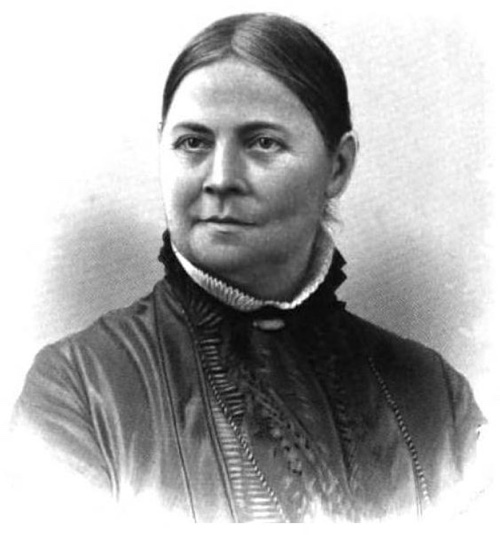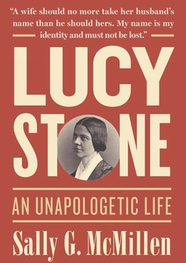The Case of the Missing Statue

In the rotunda of our nation’s Capitol stands a marble statue of three famous nineteenth-century suffragists—Susan B. Anthony, Elizabeth Cady Stanton, and Lucretia Mott. But an equally famous woman is missing: Lucy Stone. Her exclusion from the statue and her virtual absence from our nation’s history is another example of how we often overlook important people and in doing so, tell an incomplete story. In most accounts of the nineteenth-century struggle for women’s suffrage, Susan B. Anthony and Elizabeth Cady Stanton stand supreme, thus slighting Lucy’s nearly life-long devotion to this cause. In fighting for women’s rights, Stone was every bit the equal of Stanton and Anthony but has not received the attention she deserves.
 This Massachusetts
farm girl, born in 1818, grew up in a middle-class family. Even as a
child, Stone recognized the inferior status of women and the many
injustices they faced. She saw higher education as essential to her
future. Since her father refused to support her, Stone taught school
to earn enough money to pursue her dream. At the age of twenty-five,
she set off for Oberlin Collegiate Institute, the only school in the
nation offering women the opportunity to earn a college degree. She
graduated at the age of twenty-nine—the first Massachusetts woman
and one of the first women in the nation to accomplish this. Stone
then chose an unusual career for a woman--public speaking--and became
a paid lecturer for the Massachusetts Anti-Slavery Society. Months
before the 1848 Seneca Falls Convention, she added women’s rights
to her agenda.
This Massachusetts
farm girl, born in 1818, grew up in a middle-class family. Even as a
child, Stone recognized the inferior status of women and the many
injustices they faced. She saw higher education as essential to her
future. Since her father refused to support her, Stone taught school
to earn enough money to pursue her dream. At the age of twenty-five,
she set off for Oberlin Collegiate Institute, the only school in the
nation offering women the opportunity to earn a college degree. She
graduated at the age of twenty-nine—the first Massachusetts woman
and one of the first women in the nation to accomplish this. Stone
then chose an unusual career for a woman--public speaking--and became
a paid lecturer for the Massachusetts Anti-Slavery Society. Months
before the 1848 Seneca Falls Convention, she added women’s rights
to her agenda.
By the 1850s, Lucy Stone had become one of the most famous women in America. As a captivating lecturer, she drew hundreds, sometimes thousands, of people to hear her message. Her delivery was extemporaneous and uncompromising, filled with passion, tales of injustice, and pleas to change the world—to end the odious institution of slavery and to give women the rights they deserved in a nation claiming to be democratic. Her voice quieted mobs who jeered her, and her message attracted numerous converts. Newspapers gave her broad coverage. She spoke to audiences across the nation and earned a substantial income. Stone was relentless in her determination to change the world. Adding to her fame, beginning in 1850 she became a leader of the women’s rights movement, organizing and playing a key role in several annual national women’s rights conventions.
When Stone married Henry Browne Blackwell in 1855, he let her lead her life as an independent being. A year later she made the radical decision to keep her maiden name, for she reasoned that if a man could, so, too, could a woman. After the birth of daughter Alice, she cut back on lecturing but publicly protested the taxation of women without representation. During the Civil War, she helped found and lead the American Equal Rights Association to carry on the fight to end slavery.
After the Civil War, it was the debate over black male citizenship and suffrage that led to a rift in the women’s movement and indirectly to Stone’s near disappearance from history. She and most abolitionists supported the Fourteenth and Fifteenth Amendments. Anthony and Stanton opposed the amendments; women should be first. In 1869 these two women founded the National Woman Suffrage Association (NWSA). Months later, determined to continue the fight for woman suffrage but unable to work with Stanton and Anthony, Stone co-founded the American Woman Suffrage Association (AWSA). The next year, she and her family moved to Boston where she founded the Woman’s Journal, the nation’s most important and enduring women’s newspaper. Stone also played a prominent role in the AWSA as members pursued women’s suffrage state-by-state.
Ultimately, as can happen, Stone ended up on the wrong side of history with the publication of the History of Woman Suffrage, its first two volumes created and edited by Stanton, Anthony, and Matilda Joslyn Gage. The three women gathered material for their publication, almost all of it from the perspective of the NWSA and its members. Stone refused to contribute, feeling that one organization and its leaders could not produce an unbiased history of an entire movement. Also, she believed it was too early to write about a movement still in progress—suffrage had not yet been won. Not only did she not contribute, but she urged several followers to refuse as well. Thus, in this monumental work—still one of the most important sources for historians when researching the women’s movement—there is scant mention of the AWSA and the work of hundreds of women in that organization, including Stone. Stanton’s daughter Harriot recognized this serious omission and added a single chapter to volume two that covered the AWSA. Nevertheless, Stanton and Anthony successfully made their own actions and their organization pre-eminent.
Personal character can also explain one’s absence from history. The humble rarely receive the recognition they deserve. Such was true of Lucy Stone. For her, it was the movement, not the individuals leading it, who mattered--far different from Stanton and Anthony who loved the limelight. During Stone’s lifetime, journalists who begged to write about her were turned away. Almost none of her speeches were written down. Nor did she write about herself. Stanton completed her autobiography in 1898, and Anthony commissioned Ida Harper to write her biography that grew to three volumes, every word of which Anthony approved. Stone’s humility put her in the shadows, especially when up against others who did so much to promote themselves.
Lucy Stone, one of the most famous women in nineteenth-century America, spent her life trying to make our world better. Certainly she deserves a prominent place on that marble statue and in our history books. One can’t help but wonder how many other heroes and heroines in our past have yet to be recognized for their role in history.